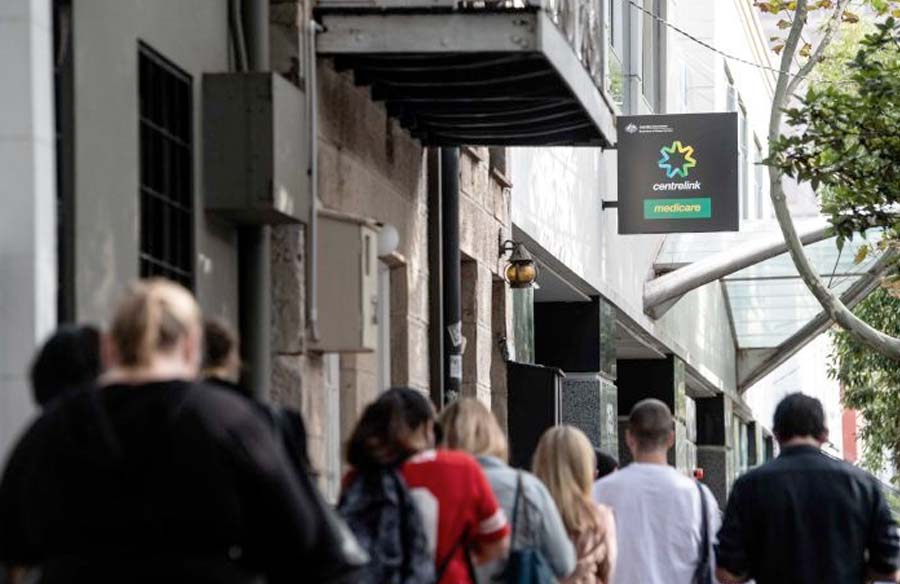The Federal Government’s wage subsidy plan will help more than 6 million people who have seen their income fall because of the coronavirus pandemic.
The JobKeeper scheme gives affected businesses $1,500 per fortnight per employee to help pay the wages of an estimated 6.7 million Australians for six months.
Employers will need to apply for the wage subsidy, and they have been. By late Tuesday more than 270,000 businesses had registered their interest.
But if you’re confused about which payment you’re entitled to (JobKeeper or JobSeeker), we’ve broken it down for you.
First, let’s recap. To be eligible for the JobKeeper payment you need to meet all these conditions:
- You are currently employed (including those stood down or re-hired) by an eligible employer;
- You were employed by the employer at March 1, 2020
- You are full-time, part-time, or long-term casuals (a casual employed on a regular basis for longer than 12 months as at March 1, 2020)
- You are at least 16 years of age
- You are an Australian citizen, the holder of a permanent visa, a Protected Special Category Visa holder, a non-protected Special Category Visa holder who has been residing continually in Australia for 10 years or more, or a Special Category (Subclass 444) Visa holder
- You are not in receipt of a JobKeeper Payment from another employer.
What if I’ve been stood down?
If you have been stood down since March 1, you are eligible for the JobKeeper payments. Your company will need to sign up for the wage subsidy scheme in order for you to receive them.
Employers are eligible to register if their business has an annual turnover of less than $1 billion and has experienced a 30 per cent fall in revenue since March 1.
Companies with an annual turnover of more than $1 billion will have to have a 50 per cent fall in revenue to be eligible for the scheme.
Businesses subject to a major bank levy will be ineligible.
However, if there’s no chance of you being re-hired — if your employer can’t reopen their business under the lockdown restrictions — then you’ll need to apply for the JobSeeker payment.
This will also be the case if your company doesn’t sign up for the scheme.
If you are self-employed you will need to register your interest in applying for the JobKeeper payment via the Australian Taxation Office (ATO).
Remember, if you receive the JobKeeper payment, this will qualify as income when it comes to calculating any other payments you might be receiving.
What if the company closes and I’m laid off?
If the company shuts its doors and you’re made redundant or fired, you’ll have to apply for JobSeeker.
For the next six months, this will be boosted by the Coronavirus Supplement, which effectively doubles your payments.
What if my hours have been cut down but I’m still working?
Again, this depends on whether your employer applies for the wage subsidy.
Assuming they did apply, to receive the JobKeeper payment you must be a full-time or part-time employee or a long-term casual — meaning you had been employed on a regular basis for longer than 12 months as at March 1.
Treasurer Josh Frydenberg told the ABC’s 7.30 program that because of the one-year minimum, “there will be casuals who are not eligible for the JobKeeper supplement”.
“What they will do is go on to the JobSeeker supplement, which is available to them at $550 on top of the old Newstart or JobSeeker payment.”
However, you’ll need to meet the income tests to receive JobSeeker, and your partner’s income will also be factored in.
Space to play or pause, M to mute, left and right arrows to seek, up and down arrows for volume. Video: Treasurer Josh Frydenberg said the JobKeeper scheme would benefit the hardest-hit sectors. (7.30)
What if I’ve already applied for JobSeeker? Or I’m entitled to both?
The Federal Government has encouraged Australians not to withdraw their applications for Centrelink benefits, if they think they’re eligible for wage subsidies instead.
Assistant Treasurer Michael Sukkar said the Government would work out which one they should receive.
“The ATO, Services Australia, where there are applications for both, obviously work out administrative arrangements to ensure that those individuals get the JobKeeper payment,” he said.
“And at that point in time, all of the other applications will be removed.
“So, I would caution them not to withdraw an application at this point in time.”
You can’t be paid both JobSeeker and JobKeeper — it’s one or the other.
What about workers who earn less than the JobKeeper payment?
The JobKeeper payment is the same for everyone, no matter how much they earn. It’s the equivalent of 70 per cent of the median wage.
For industries hit hard — such as hospitality, retail and tourism — the Government says it’s the same as the median wage.
So even if you earn less than $1,500 a fortnight, you will receive the full payment if you’re eligible.
If you usually earn more, the Government hopes for businesses to top up employees’ earnings to bridge the gap.
What other help is there?
The big four banks have all announced that their customers will be able to pause mortgage payments.
You should contact your bank to find out what help they’re able to provide.
The National Cabinet has also agreed to a moratorium on evictions over the next six months for commercial and residential tenancies in financial distress who are unable to meet their commitments due to the impact of coronavirus.
source:ABC


